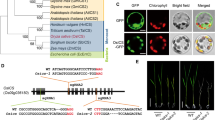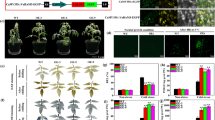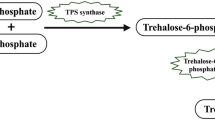Abstract
Vitamin C (L-ascorbic acid, AsA) is a compound which provides major nutritional value, both for plants and humans. In this study, three distinct metabolic engineering strategies, including overexpression of biosynthesis enzyme, suppression of catabolism enzyme and switching the sub-cellular localization of compartment enzyme, were employed to enhance the production of AsA in Arabidopsis thaliana. The results showed that (1) overexpression of L-Galactose-1-P Phosphatase (GalPPase) enhanced AsA content to 3.96 µmol/g FW, which was 1.6-fold more than that in their wild-type (WT) counterparts; (2) RNAi suppression of ascorbate oxidase (AO) resulted in a significant increase of AsA accumulation (0.86 µmol/g FW) in apoplast; (3) both mitochondrion-target and none-target overexpression of L-Galactose dehydrogenase (GalDH) did not significantly promote AsA production compared with WT (1.96 µmol/g), however a dramatic enhancement was observed following infiltration with L-galactono-1, 4-lactone (L-GalL), both in transgenic and WT plants. The best line produced AsA with the content of 3.90 µmol/g FW, which was about 2-fold of that in the untreated control (1.99 µmol/g FW). This study provides new strategies including GalPPase overexpression, AO suppression as well as L-GalL feeding for modern breeding aimed at stimulating the AsA content in plants.
Similar content being viewed by others
References
Tóth, S. Z., G. Schansker, and G. Garab (2013) The physiological roles and metabolism of ascorbate in chloroplasts. Physiol. Plantarum. 148: 161–175.
Hameed, A., S. Gulzar, I. Aziz, T. Hussain, B. Gul, and M. A. Khan (2015) Effects of salinity and ascorbic acid on growth, water status and antioxidant system in a perennial halophyte. AoB Plants. pii: plv004.
Domínguez-Perles, R., P. Mena, C. García-Viguera, and D. A. Moreno (2014) Brassica foods as a dietary source of vitamin C
Park, Y. S., M. H. Im, K. S. Ham, S. G. Kang, Y. K. Park, J. Namiesnik, H. Leontowicz, M. Leontowicz, E. Katrich, and S. Gorinstein (2013) Nutritional and pharmaceutical properties of bioactive compounds in organic and conventional growing kiwifruit. Plant Foods Hum. Nutr. Mar. 68: 57–64.
Pappenberger, G. and H. P. Hohmann (2014) Industrial production of l-ascorbic acid (Vitamin C) and d-Isoascorbic Acid. Adv. Biochem. Eng. Biotechnol. 143: 143–188.
Smirnoff, N., P. L. Conklin, and F. A. Loewus (2001) Biosynthesis of ascorbic acid in plants: A renaissance. Annu. Rev. Plant Physiol. Plant Mol. Biol. 52: 437–467.
Cronje, C., G. M. George, A. R. Fernie, J. Bekker, J. Kossmann, and R. Bauer (2012) Manipulation of L-ascorbic acid biosynthesis pathways in Solanum lycopersicum: Elevated GDP-mannose pyrophosphorylase activity enhances L-ascorbate levels in red fruit. Planta. 235: 553–564.
Tokunaga, T., K. Miyahara, K. Tabata, and M. Esaka (2005) Generation and properties of ascorbic acid-overproducing transgenic tobacco cells expressing sense RNA for L-galactono-1,4-lactone dehydrogenase. Planta. 220: 854–863.
Wang, Z. N., Y. Xiao, W. S. Chen, K. X. Tang, and L. Zhang (2010) Increased Vitamin C content accompanied by an enhanced recycling pathway confers oxidative stress tolerance in arabidopsis. J. Integr. Plant Biol. 52: 400–409.
Zhou, Y., Q. C. Tao, Z. N. Wang, R. Fan, Y. Li, X. F. Sun, and K. X. Tang (2012) Engineering ascorbic acid biosynthetic pathway in Arabidopsis leaves by single and double gene transformation. Biologia Plantarum. 56: 451–457.
Conklin, P. L. (2001) Recent advances in the role and biosynthesis of ascorbic acid in plants. Plant Cell Environ. 24: 383–394.
Sakamoto, S., Y. Fujikawa, N. Tanaka, and M. Esaka (2012) Molecular cloning and characterization of L-galactose-1-phosphate phosphatase from tobacco (Nicotiana tabacum). Biosci. Biotechnol. Biochem. 76: 1155–1162.
Conklin, P. L., S. Gatzek, G. L. Wheeler, J. Dowdle, M. J. Raymond, S. Rolinski, M. Isupov, J. A. Littlechild, and N. Smirnoff (2006) Arabidopsis thaliana VTC4 encodes L-galactose 1-phosphate phosphatase, a plant ascorbic acid biosynthetic enzyme. J. Biol. Chem. 281: 15662–15670.
Ioannidi, E., M. S. Kalamaki, C. Engineer, I. Pateraki, D. Alexandrou, I. Mellidou, J. Giovannonni, and A. K. Kanellis (2009) Expression profiling of ascorbic acid-related genes during tomato fruit development and ripening and in response to stress conditions. J. Exp. Bot. 60: 663–678.
Naohiro, K. and E. Muneharu (1999) Changes in ascorbate oxidase gene expression and ascorbate levels in cell division and cell elongation in tobacco cells. Physiol. Plantarum. 105: 321–329.
Pignocchi, C., J. M. Fletcher, J. E. Wilkinson, J. D. Barnes, and C. H. Foyer (2003) The function of ascorbate oxidase in tobacco. Plant Physiol. 132: 1631–1641.
Ali, N., S. K. Datta, and K. Datta (2010) RNA interference in designing transgenic crops. GM Crops. 1: 207–213.
Gatzek, S., G. L. Wheeler, and N. Smirnoff (2002) Antisense suppression of L-galactose dehydrogenase in Arabidopsis thaliana provides evidence for its role in ascorbate synthesis and reveals light modulated L-galactose synthesis. Plant J. 30: 541–553.
Conklin, P. L., J. E. Pallanca, R. L. Last, and N. Smirnoff (1997) L-Ascorbic acid metabolism in the ascorbate-deficient Arabidopsis mutant vtc1. Plant Physiol. 115: 1277–1285.
Maarse, A. C., A. P. Van Loon, H. Riezman, I. Gregor, G. Schatz, and L. A. Grivell (1984) Subunit IV of yeast cytochrome c oxidase: cloning and nucleotide sequencing of the gene and partial amino acid sequencing of the mature protein. EMBO J. 3: 2831–2837.
Clough, S. J. and A. F. Bent (1998) A simplified method for Agrobacterium-mediated transformation of Arabidopsis thaliana. Plant J. 16: 735–743.
Yang, H. Q., Y. J. Wu, R. H. Tang, D. Liu, Y. Liu, and A. R. Cashmore (2000) The C termini of Arabidopsis cryptochromes mediate a constitutive light response. Plant Cell. 103: 815–827.
Doyle, J. J. and J. L. Doyle (1990) Isolation of plant DNA from fresh tissue. Focus. 12: 13–15.
Jaakola, L., A. M. Pirttila, M. Halonen, and A. Hohtola (2001) Isolation of high quality RNA from bilberry (Vaccinium myrtillus L.) fruit. Mol Biotechnol. 19: 201–203.
Sanmartin, M., P. D. Drogouti, T. Lyons, J. Barnes, and A. K. Kanellis (2003) Overexpression of ascorbate oxidase in the apoplast of transgenic tobacco results in altered ascorbate and glutathione redox states and increased sensitivity to ozone. Planta. 216: 918–928.
Turcsányi, E., T. Lyons, M. Plöchl, and J. D. Barnes (2000) Does ascorbate in the mesophyll cell walls form the first line of defence against ozone? Testing the concept using broad bean (Vicia faba L.).
Moser, O. and A. K. Kanellis (1994) Ascorbate oxidase of Cucumis melo L. var. reticulatus: Purification, characterisation and antibody production. J. Exp Bot. 45: 717–724.
Moore, A. L. and M. O. Proudlove (1983) Mitochondria and submitochondrial particles. pp. 153–184. In: J. L. Hall and A. L. Moore (eds.). Isolation of Membranes and Organelles from Plant Cells. Academic Press, London, UK.
Ren, J., Z. Chen, W. Duan, X. Song, T. Liu, J. Wang, X. Hou, and Y. Li (2013) Comparison of ascorbic acid biosynthesis in different tissues of three non-heading Chinese cabbage cultivars. Plant Physiol. Biochem. 73: 229–236.
Hancock, R. D. and R. Viola (2002) Biotechnological approaches for L-ascorbic acid production. Trends Biotechnol. 20: 299–305.
Yoshimura, K., T. Nakane, S. Kume, Y. Shiomi, T. Maruta, T. Ishikawa, and S. Shigeoka (2014) Transient expression analysis revealed the importance of VTC2 expression level in light/dark regulation of ascorbate biosynthesis in Arabidopsis. Biosci. Biotechnol. Biochem. 78: 60–66.
Lin, L. S. and J. E. Varner (1991) Expression of ascorbate oxidase in zucchini squash (Cucurbita pepo). Plant Physiol. 96: 159–165.
Esaka, M. (1998) Gene expression and function of ascorbate oxidase in higher plants. Recent Res. Dev. Phytochem. 2: 315–326.
Smirnoff, N. (2000) Ascorbic acid: Metabolism and functions of a multifaceted molecule. Curr. Opin. Plant Biol. 3: 229–235.
Schmitz, U. K. and D. M. Lonsdale (1989) A yeast mitochondrial presequence functions as a signal for targeting to plant mitochondria in vivo. Plant Cell. 8: 783–791.
Hernould, M., S. Suharsono, S. Litvak, A. Araya, and A. Mouras (1993) Malesterility induction in transgenic tobacco plants with an unedited atp 9 mitochondrial gene from wheat. Proc. Natl. Acad. Sci. USA. 90: 2370–2374.
Kohler, H. R., R. W. Zipfel, W. W. Webb, and R. M. Hanson (1997) The green fluorescent protein as a marker to visualize plant mitochondria in vivo. Plant J. 11: 613–621.
Nizampatnam, N. R., H. Doodhi, Y. Kalinati Narasimhan, S. Mulpuri, and D. K. Viswanathaswamy (2009) Expression of sunflower cytoplasmic male sterility-associated open reading frame, orfH522 induces male sterility in transgenic tobacco plants. Planta. 229: 987–1001.
Momma, M. and Z. Fujimoto (2013) Expression, crystallization and preliminary X-ray analysis of rice L-galactose dehydrogenase. Acta Crystallogr. Sect. F Struct. Biol. Cryst. Commun. 69: 809–811.
Xu, Y., X. Zhu, Y. Chen, Y. Gong, and L. Liu (2013) Expression profiling of genes involved in ascorbate biosynthesis and recycling during fleshy root development in radish. Plant Physiol. Biochem. 70: 269–277.
Author information
Authors and Affiliations
Corresponding authors
Additional information
These two authors contributed equally to this work
Rights and permissions
About this article
Cite this article
Xiao, L., Xiao, Y., Wang, Z. et al. Metabolic engineering of vitamin C production in Arabidopsis . Biotechnol Bioproc E 20, 677–684 (2015). https://doi.org/10.1007/s12257-015-0090-4
Received:
Revised:
Accepted:
Published:
Issue Date:
DOI: https://doi.org/10.1007/s12257-015-0090-4




